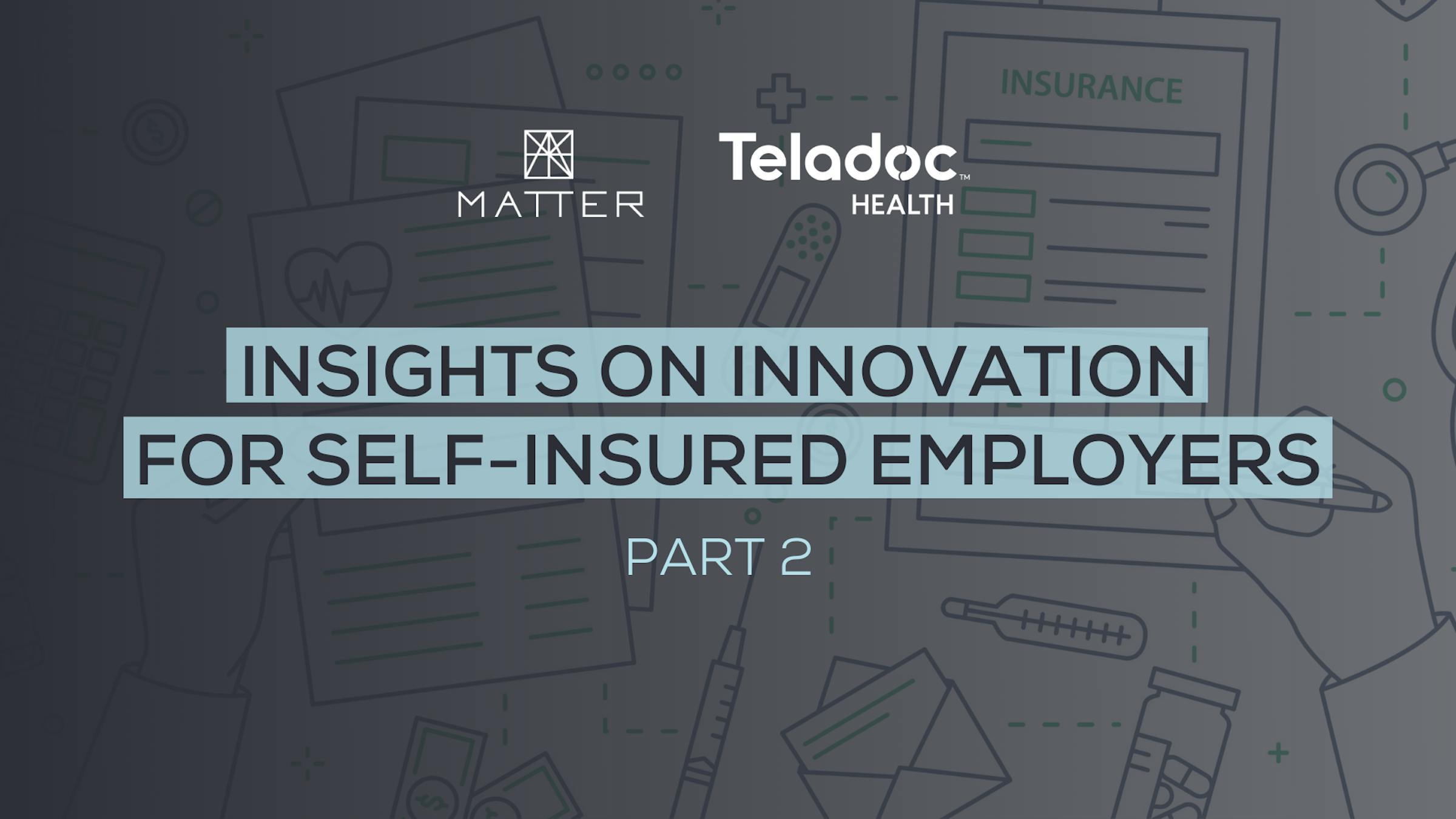Next-generation employee health solutions: What works and what doesn’t
Employee health and wellness solutions have often been seen as “check-the-box” tools that large employers should have as part of their benefits offering, but when it comes to measuring ROI — either in improved health or expense savings — these tools have often fallen short. A new generation of technologies and services promise to change this equation. Today’s self-insured employers have their pick from a wide array of new solutions promising to add value for their employees and to their bottom lines.
Our newest program series produced in partnership with Livongo (now a Teladoc Health company), Insights on Innovation for Self-insured Employers, is designed to help employers further advance their healthcare innovation strategies and help industry innovators understand how to best collaborate with them. At the second event in the series, MATTER CEO Steven Collens led a conversation with Courtney Stubblefield, solutions function leader for Willis Towers Watson’s Health & Benefit business, and Glen Tullman, founder and former executive chairman of Livongo and managing partner at 7Wire Ventures. The conversation dug into how employers are making decisions about which solutions to acquire for their employee populations, how they’re measuring outcomes, what works, what doesn’t, and how to define positive ROI.
Watch the full event at matter.health/live, and read the recap of part one of this series.
Following are our key takeaways from the event. Responses have been edited slightly for length and clarity.
How employers are choosing solutions
Courtney: “When deciding which health solutions to acquire for their employees, there are a myriad of things that employers are looking for. With the technology and product innovation that has come out over the last several years, employers are looking for value in terms of economic value, better quality of care and better health outcomes while also improving the employee experience by helping people better meet their own needs and personalize care in new ways.
“It’s also very important for them to clearly define how a solution will fit into their environment. Most employers have well-defined strategies around their employee value proposition down to their healthcare strategy. Anything that they add in is required to add value, not confuse employees and befuddle the ecosystem.”
“A key question to answer is, how will this potential solution fit into the current model? Does it displace an existing process and is it better than what we’re doing today, or is it complimentary? As a consultant, there’s a lot of design thinking that goes into looking at what needs to come into play and how we evaluate it.”
Most employers have well-defined strategies around their employee value proposition down to their healthcare strategy. Anything that they add in is required to add value, not confuse employees and befuddle the ecosystem. - Courtney Stubblefield, Willis Towers Watson
Glen: “With the COVID-19 pandemic, there have been two big pushes. The first is that employers — large self-insured employers in particular — have realized how critical it is to keep people healthy, from the warehouse to the office. The second is that we continue to face economic challenges, causing employers to look very carefully at expenses. Most employers will tell you that their largest uncontrollable expense is healthcare.
“One thing that I believe employers are really looking for is alignment — whether it’s a payer, a PBM (pharmacy benefit manager) or a health system. And part of our challenge today is that our system is set up so that when payers, PBMs and health systems make more money, employers pay more money. There’s a lack of alignment there. That’s where we’re going to see a lot more shared savings from those three groups as well as from the vendor community. We have hundreds of solutions now. The goal is to first figure out how we make that an easier experience for the employee, and then ask: how do we make it easier to do business for the employer?
“If you talked to a lot of our self-insured employers, what they’d say is ‘I’ve got 10 different companies in every area coming at me, how do we organize that? How does an employee with multiple chronic conditions organize their care?’ The world has become more complex, more confusing and more costly than ever before. An employee could have four coaches, three apps and more. This idea of helping employers organize these resources for the individual is an innovation in itself. Can we get someone to put these disparate solutions together and create a new, more holistic kind of experience?
The world has become more complex, more confusing and more costly than ever before… This idea of helping employers organize these resources for the individual is an innovation in itself. - Glen Tullman, Livongo
Quantifying value add for new solutions
Courtney: “The weight is shifting toward employers wanting to see the economic value and positive ROI for the solutions they implement. Employers see that there’s been a period of time where adoption grew over the last five-plus years, and with that, a willingness to add more into their strategy and their ecosystem to see what can meet needs better. I think we’ve reached a moment where more than half the value equation now is tied to economic impact and improved health outcomes. But the need to show qualitative value for employees and their families is still there. In my work, I’m often focused on the ways we can help employers assess that sort of effectiveness using data.
“It’s also about change management at some level when we start to talk about shifting to value-based care solutions. We have been spending years trying to identify the right ways to change how healthcare is paid for — and there has been very slow progress. Employers have borne the brunt of being the commercial payers that pay the most, but the solutions that have emerged initially require a lot of change.
“We’re seeing this movement of working to integrate those solutions more deeply into the health plan. When a solution gets added to the health plan, typically a plan provided by a large major carrier, how do we steer people through that change and what are other solutions that can help? There is a whole suite of emerging solutions that provide treatment decision support with incredible services wrapped around them. I want to continue to see an evolution from just point solutions to something that really can transform how an individual is intercepted, reaches into that solution for their needs, then uses it to propel themselves as needed through the healthcare system in a more effective way.”
I want to continue to see an evolution from just point solutions to something that really can transform how an individual is intercepted, reaches into that solution for their needs, then uses it to propel themselves as needed through the healthcare system in a more effective way. - Courtney Stubblefield, Willis Towers Watson
Defining success and measuring solution performance
Courtney: “Across the board, employers are expecting some type of skin-in-the-game guarantees for the performance of the solution. What those guarantees are will depend on the nature of the solution and what it does. In the early days, and even still today, ‘engagement’ is a key buzzword. What are engagement levels? What are the completion levels for these programs? What are the sets of clinical performance metrics for a quality or navigation-based solution? How effective is the solution in driving people to the right care? What’s the uptake rate?
“Increasingly, what employers want to see is getting paid based on performance entirely — going at full risk for clinical improvements for sustained participation, for high satisfaction and ultimately for improving cost. Some of our deep analytic experts and actuaries are working on ways to measure that, whether that be determining what those critical measures are based on the type of solution domain and assessing avoided readmissions, to reducing the number of surgeries in a particular category because they’re redirected to less aggressive care.”
Aligning incentives to prioritize consumer-directed healthcare
Courtney: “We’re effectively talking about some level of disintermediating the traditional health plan. Currently, we have such an entrenched legacy model, with the national carriers providing the network and discounts. When we start talking about solutions that start to disintermediate that the key question becomes: Will this deliver value if we’re just paying for lots of different parties to do different things?
“Then we’re not being productive — there are no economic savings, health outcomes are not improving, we’re not eliminating wasteful care or avoiding unnecessary care. Then this could be expensive and not a good result. We’re committed to the belief that there is a better way to do this. I think it takes organizations like consulting firms and advisory firms to help package things right and help employers step into this without having to piecemeal these solutions together themselves.”
Glen: “There is a lot of chatter going on about misaligned incentives. If you’re a health system, you get paid to get people into your hospital and get those beds filled. That’s the way most health systems still work today. That is just the reality of what happens. But in fact, the better choice is to first try solutions that keep people out of the hospital. We have to get to a different system that really is focused on what’s best for the individual, and then what’s best for the person paying the bill, which in about half the cases in this country are businesses.”
There’s a lot of chatter going on about misaligned incentives. If you’re a health system, you get paid to get people into your hospital and get those beds filled… But in fact, the better choice is to first try solutions that keep people out of the hospital. - Glen Tullman, Livongo
Want to hear from more healthcare innovators? Visit matter.health/events to see our lineup of upcoming programs.



